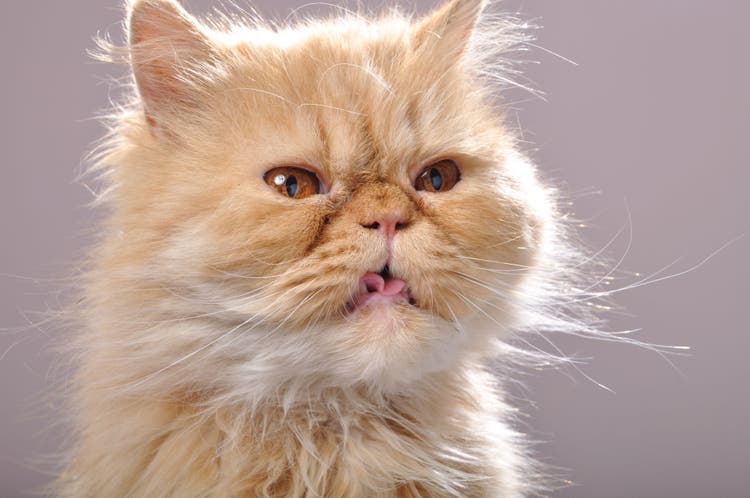
Panting in Cats – Is It Normal?
Panting in Cats – Is It Normal?
Some of us have occasionally seen our cats panting – those rapid, shallow respirations characterized by open-mouthed breathing and protruding tongue. Panting is uncommon in cats and is not considered normal though some cats can pant after brisk play or in times of stress, such as a car ride. Even though your cat may periodically pant, should you be concerned?
That all depends. In general, panting is not considered normal in cats. It can occur with stress or after periods of excessive exertion, however, it may represent a more severe, even life-threatening illness and should not be ignored.
Why Cats Pant
There are many causes of panting in cats. Most commonly it is in response to environmental changes, such as anxiety, fear, excitement, or heat. However, if panting is excessive or your cat is in distress, it is important to identify the underlying cause. Some of these causes are:
- Respiratory Disorders. It might be an upper respiratory tract problem such as nasal blockages or growths in the nose and pharynx. In the lower respiratory tract, problems might include an inadequate exchange of gases, pulmonary edema, or asthma. Disease of the chest cavity might include air, fluid or masses in the chest cavity, or diaphragmatic hernias.
- Cardiovascular Disorders. The heart might be affected by disorders such as heartworm disease or heart failure. The lungs may be affected by pulmonary embolism.
- Hematologic Disorders. Blood disease is sometimes a factor. Common disorders are anemia and carbon monoxide poisoning.
- Neurologic Disorders. Diseases of the nervous system can also affect the respiratory center. Some of these might involve head trauma, brain tumors, or dysfunction of the respiratory muscles.
- Miscellaneous Disorders. Some other problems that can affect breathing are drug poisoning, high altitude, abdominal pressure caused by pregnancy, fluid in the abdomen or some diseases.
What Should You Do?
If you notice excessive panting in your cat, look for signs of immediate distress like coughing, difficulty breathing (dyspnea), or blue color to the mucous membranes (cyanosis). Be on the alert, too, for other problems, such as fatigue, weight loss, poor appetite, excessive drinking, vomiting, or diarrhea.
If it appears that your pet is panting in response to normal events such as exercise, excitement, heat or fear, remove the stimulation and continue to observe your pet. If panting continues, consult your veterinarian.
Some Initial Tests Your Vet May Do
Your veterinarian may recommend one or more of the following diagnostic tests to determine the cause of your pet’s panting.
- Complete blood count and urinalysis. A complete blood count (CBC), biochemical profile, and urinalysis may suggest conditions such as anemia, infection or diabetes. An arterial blood gas assesses the acid-base status.
- X-rays. Your vet may want to x-ray your pet’s chest and abdomen to be sure there are no foreign bodies or tumors present in the upper respiratory tract.
- Ultrasound. An ultrasound of the heart, chest, and abdomen evaluates the size of the organs and detects the presence of fluid or masses.
More Specific Tests For Panting Cats
If your vet is unable to make a definitive diagnosis with the initial tests, further tests will be needed.
- Endocrine testing. A thyroid (T4) level may be indicated in cats older than 6 years of age.
- A heartworm test. The presence of heartworms in cats occludes the vessels of the heart and affects breathing.
- Thoracentesis. Occasionally your vet may want to perform a thoracentesis, a procedure to withdraw fluid, air, or tissue from the chest.
Treatment of Panting Cats
Even before a diagnosis is made, your vet will probably treat your pet’s symptoms. Initially, he will recommend strict rest and oxygen therapy. But he may also offer other treatments:
- If your cat is dehydrated from vomiting or diarrhea, he may start IV fluid therapy.
- Blood transfusion may be indicated in the presence of severe anemia.
- Antibiotics or anti-inflammatory drugs may be administered for infection or inflammation.
- Once the cause of your cat’s problem is determined, your vet will prescribe specific treatment. While caring for your cat at home, be sure to administer all prescribed medications. Keep your cat in a cool, stress-free environment and avoid overexertion. And finally, return for follow-up evaluation as directed by your veterinarian.